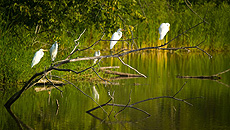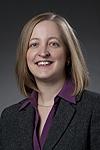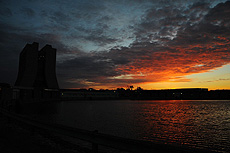|
Wednesday, Oct. 10
- Breakfast: breakfast strata
- White-chicken chili
- California chopped-pork sandwich
- Beef stroganoff
- Smart cuisine: ancho chili barbecue beef
- Italian antipasto sandwich
- Pepperoni lover's calzone
- Mumbo jumbo baked potatoes
Wilson Hall Cafe Menu |
|
Wednesday, Oct. 10
Lunch
- Baked cornish hens with mustard sauce
- Broccoli and rice
- Pumpkin pie with spiced cream
Friday, Oct. 12
Dinner
- Coquille St. Jacques
- Pork tenderloin with porcini sauce
- Cauliflower gratin
- Green bean amandine
- Apple pie with vanilla bean ice cream
Chez Leon Menu
Call x3524 to make your reservation.
|
|
Caring for the prairie
 |
White egrets gather near a pond on the Fermilab site. The laboratory's stewardship program relies on volunteers to continue Fermilab's distinguished history of environmentally responsible land management. Photo: Reidar Hahn
|
Ryan Campbell, an ecologist with Fermilab's Roads and Grounds Group, leans back in his office chair on a hot, humid Illinois summer morning. His gaze fixes on a large aerial photograph of the Fermilab property, on which he'd placed nametags on some of the large swaths of green fields and forests.
"See those names?" he says. "Those are the stewards—like this guy Johnny? This is a big area, but he's taking care of it in terms of invasive species, biodiversity." He pointed to another green region on the map. "Same with these folks over here and those two folks are working over there."
Since its inception, Fermilab has been dedicated to environmental stewardship. The laboratory's first director, Robert Wilson, and Northeastern Illinois University biologist Robert Betz began prairie restoration programs across the 6800-acre site, emphasizing the natural history of the Midwest. Today, much of that environmental work continues with the assistance of the private non-profit Fermilab Natural Areas.
Campbell, who is also the field project manager of Fermilab Natural Areas, started a stewardship program late last year as a way to help manage the tallgrass prairie and woodlands present on the site. He assigned plots of land to interested employees and trained volunteers, matching them by the stewards' skill sets and interests. The management work includes surveying plants, collecting seed and removing invasive species such as crown vetch, teasel and reed canary grass.
"By managing these plots, the stewards take pride in ownership," Campbell says, comparing the steward program to an adopt-a-road venture.
Together with Fermilab Natural Areas President and Fermilab ecologist Rod Walton, Campbell began to attract people to adopt sections of Fermilab property to manage. One such person is Sue Sheehan, a Fermilab employee who is in charge of the docents at the Lederman Science Center. She and colleagues Lori Haseltine and Bob Shaw work on a plot close to the near detector for Fermilab's MINOS experiment, which is designed to observe neutrino oscillations.
"We take surveys of the plot, just to get an idea of what's living there," Sheehan says. "It gives us a ballpark estimate."
Read more
—Joseph Piergrossi
|
University of Oklahoma
NAME:
University of Oklahoma
HOME TOWN:
Norman, Okla.
MASCOT:
Sooner Schooner
COLORS:
Crimson and cream
COLLABORATING AT FERMILAB SINCE:
mid-1980s
WORLDWIDE PARTICLE PHYSICS COLLABORATIONS:
ATLAS (CERN), DZero
NUMBER OF SCIENTISTS AND STUDENTS INVOLVED:
Seven faculty, seven postdocs, 12 graduate students
PARTICLE PHYSICS RESEARCH FOCUS:
Our group takes a three-prong approach to research, one that involves hardware, computing and analysis. For DZero analysis, we have been focusing on many different areas, including B physics, top physics, Higgs and QCD. Our ATLAS research has been focusing on SUSY, top and Higgs physics. We have been involved with silicon detectors for many years, including helping test DZero silicon detectors, assisting in the design and fabrication for the pixel detector for ATLAS and working on the design and construction of the inner B layer for ATLAS. Our computing effort has been in Monte Carlo production for DZero and the operation of a Tier 2 center for ATLAS. The theory group works closely with the HEP experimentalists, since two of our theorists focus on high-energy phenomenology — especially supersymmetry — oriented toward the physics that is starting to emerge from the Large Hadron Collider. Our theory group also works on nonperturbative quantum field theory.
WHAT SETS PARTICLE PHYSICS AT THE UNIVERSITY OF OKLAHOMA APART?
OU has a vibrant HEP experimental group involved in hardware, computing and physics. We have a close collegial environment and a close collaboration between our theory and experimental groups. We take education seriously and have several award-winning professors in research and teaching. We are one of the original QuarkNet institutions.
FUNDING AGENCIES:
DOE, DOE Epscor, NSF
View all university profiles.
|
In search of sterile neutrinos
From Physics, Oct. 4, 2012
Neutrinos emerge from weak nuclear reactions in the sun, but for decades, detectors on earth measured only about a third of the expected number. This difference arises, we now know, because different neutrino flavors are mixtures of states that vary slightly in mass, so the original electron neutrinos transform over their long transit into muon and tau neutrinos, which the early detectors couldn't see. Some physicists suspect that a similar oscillation may underlie small discrepancies in neutrino counts at several earthbound reactors. Explaining changes over distances of meters, however, requires new flavors of neutrinos with mass differences perhaps a hundred times larger, and which have no detectable interactions.
Read more
|
|
Fermilab Today survey results
 |
|
Katie Yurkewicz |
Katie Yurkewicz, head of the Office of Communication, wrote this column.
This summer, we asked our readers to complete a survey on what they liked about Fermilab Today and what we could do to improve it. The results are in, and we have begun planning a better publication based on your feedback and suggestions. We sincerely thank you for taking the time to respond and submit comments.
Nearly 1,200 of you took the survey. That's 30 percent of the roughly 4,000 people who receive Fermilab Today every day. On the whole, readers are happy with the laboratory's daily publication:
- Three quarters of respondents read Fermilab Today every day.
- Most of you find Fermilab Today useful, timely, interesting and of consistent quality. You also find it to be just the right length – almost 70 percent of you spend no more than 10 minutes reading it.
- Readers said they appreciated the variety of articles in Fermilab Today, which provides science articles, non-technical stories and photos.
We're glad that so many of you appreciate the newsletter. We're also glad that you care enough to suggest how we can make it better. Here are some of the most frequent suggestions we've received:
- Many of you suggested, seemingly in chorus, that Fermilab Today do more to showcase the people at Fermilab. In response, we just launched our series of occasional profiles, and we are looking for additional ways to highlight staff members and their contributions to our laboratory.
- We received several comments that the Web layout needs an update. We agree and are currently working to bring you a more Web-friendly, modern Fermilab Today.
- Readers would also like to see even more articles on science, both at Fermilab and at other laboratories. We are broadening our In the News coverage of particle physics, and we encourage you to subscribe to symmetry magazine to receive even more science articles on a daily, weekly or monthly basis—your choice.
You also identified Fermilab Today's biggest challenge: producing a publication that satisfies multiple audiences. Fermilab Today's primary audience is the laboratory's employees and users, but hundreds of people outside the laboratory also subscribe to the publication. We continually work to publish a newsletter that is of benefit to as wide an audience as possible.
We've summarized the most important survey results in a few graphs. If you'd like more information about the survey results, or if you have further suggestions on how the newsletter may better serve you, e-mail Fermilab Today at today@fnal.gov.
|
Booster sunrise
 |
Greg Vogel, AD, took this photo of the sunrise yesterday near the Booster. |
|
Fire engine on display - today
As part of National Fire Prevention Week, today from 11:30 a.m. to 12:30 p.m., the Fermilab Fire Department will display one of their fire engines in the horseshoe in front of Wilson Hall.
|
Community Planning Meeting - this week
The Community Planning Meeting, organized by the American Physical Society Department of Particles and Fields, begins tomorrow at Fermilab. The meeting sets the stage for the two-week Community Summer Study to be held next summer at the University of Minnesota. The purpose of CSS2013, held in the tradition of previous Snowmass meetings, will be to help chart the next ten years of U.S. High Energy Physics, viewed in a global context.
|
ES&H weekly report, Oct. 9
This week's safety report, compiled by the Fermilab ES&H section, contains one incident.
While opening a chemical container, an employee was splashed in the eye with ethyl alcohol and potassium hydroxide. She received first-aid treatment.
Find the full report here. |
|